 While I like to keep my discussions here coffee, beer, and historical science related some things just can’t be ignored especially when people keep poking me for answers. So, I have some thoughts that are quite lacking in insobriety.
While I like to keep my discussions here coffee, beer, and historical science related some things just can’t be ignored especially when people keep poking me for answers. So, I have some thoughts that are quite lacking in insobriety.
First, I am not a nuclear engineer, contrary to how more than a few people have referred to me; I am a health physicist. It is the purpose of my field to keep radiation doses as low as reasonably achievable (ALARA, as the acronym goes) for radiation workers and the public. More often than not, this means protecting the radiation sources from people as humans are rather dangerous when we ignorantly play with fire. So, I cannot definitively speak to the quality of the reactor’s construction or it’s current post-earthquake condition, though I’m pretty sure no one builds reactors with a M9.0 quake in mind (certainly not the outbuildings that held the cooling & filtration systems that have been damaged, never mind the rest of the city infrastructure). The job of a health physicist is now to protect the public from an accident that has gone beyond the confines of the reactor. For that, I can say things:
- If you do not live in northern Honshu, you do not have cause for panic. The radiation release from the reactor has been localized to the immediate vicinity. A downwind plume exposure pathway emergency planning zone (~10mi radius) as already been evacuated. A wider 50 mile radius will be drawn for confiscation of foodstuffs to minimize any potential ingestion of radioactive iodine & cesium.
- Please be understanding of the fact that thousands are dead from a tsunami and earthquake with associated services badly disrupted. Terrifying as a nuclear reactor having trouble may seem to you via television/internet report, there are much more lethal and immediate problems than the reactor to the people who are still in the middle of this. Just getting there to help is a logistical nightmare. Contamination can be cleaned up, but people can’t be unkilled. Life saving takes precedence over property & environment.
- Normal operations of a nuclear reactor involves the operation of air and water monitoring stations in the facility itself and area environmental monitors for many miles around. A tsunami is likely to have broken more than few of those, but many more mobile units were rushed to the scene. This is how we are keeping track of what has been/is being released to the surrounding area from the reactor.
- Radioactive materials are being released to the air in the form of radioactive steam and water. Dissolved metals in the water and small particulates are particularly prone to becoming activated and thus radioactive, especially without a functional cooling and filtration loop to clean the water up. The radioactivity is very short lived, in general on the order of minutes to about a week, but rather nasty while it is present.
- Reports have indicated the presence of small quantities radioiodine and radiocesium in monitoring. This indicates that some of the nuclear fuel cladding has been damaged due to overheating.
- Unless ordered by a medical professional, DO NOT self-administer prophylactic iodine or Prussian blue treatments to protect against radioiodine & radiocesium uptake. These treatments carry some significant metabolic risks at the body saturating doses necessary to offer protection.
- Please don’t mob the health professionals. They are badly outnumbered and doing their best. People with burns and crush injuries take precedence over potential radioactive materials uptake every time. Your latency for cancer is 40 years; their latency for a crushed arm may only be minutes. Do not be upset when they press-gang you for assistance at the triage station rather than treat you like victim, because you are still ambulatory and capable.
- The symptoms of acute radiation sickness (ARS) begin with vomiting. There’s an awful lot of things that may cause vomiting in a disaster situation like this, not the least of which is stress and psychosomatic response. At this point we will segregate you and watch for further advancement of symptoms. At present, only one person who has presented with symptoms that has had an actual radioactive materials uptake; his dose was less the 1/10th the what is normally associated with associated with ARS.
If you want to help with all of this, please, instead of buying a Stein of Science or Black Blood of the Earth go donate to the Red Cross. You will do far more good than staring at the TV with growing panic. Several colleagues I rather respect are already on their way to Japan to help with the reactor problems and I wish them the best. As endless a supply of caffeine as I can make is going with them.
I also recommend watching for announcements to come through the International Atomic Energy Agency, American Nuclear Society, and World Nuclear News.